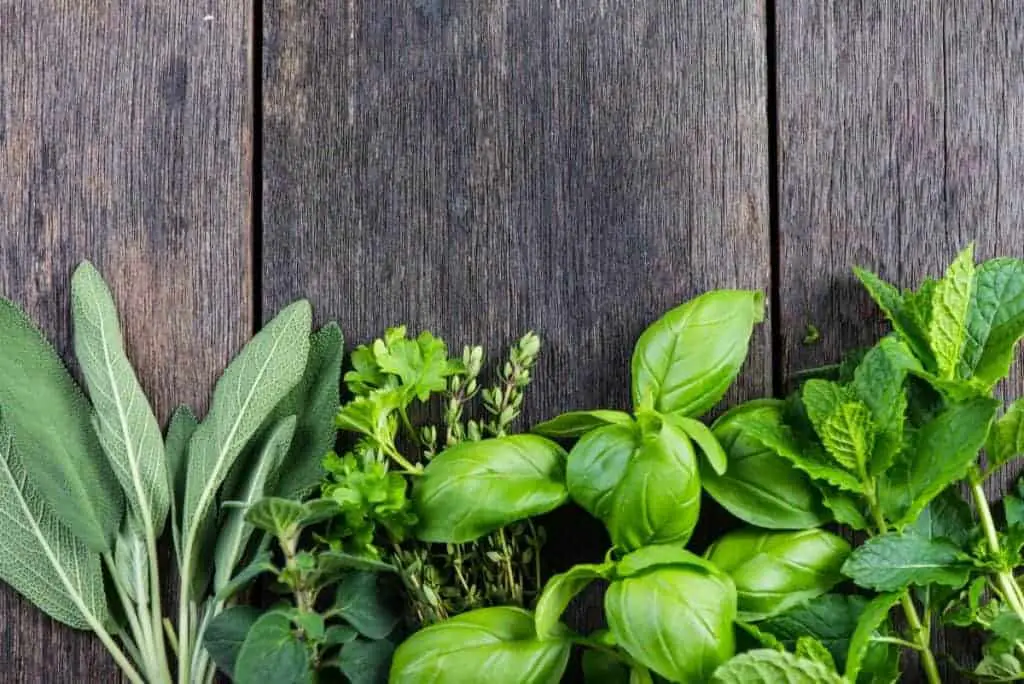This post contains affiliate links.

Basil and parsley are two of the many different kinds of leafy green herbs. These two are particularly common in many dishes. So what’s the difference between them?
The main difference between parsley and basil is most evident in the taste. While basil has a sweet/savory taste and is used in dishes to add flavor, parsley has a bright, herbaceous, slightly bitter taste and is used more for garnish than to enhance the flavors of other foods.
In addition to their looks, parsley and basil have very different origins, tastes, and medicinal uses. Understanding the differences between these two everyday herbs can enhance your cooking and may even help with some health issues.
Parsley Vs Basil: Origin
Origins play a crucial role in understanding the significance of many things, and herbs are no different.
Both of these herbs’ existence dates back thousands of years. However, their suspected origins differ in region and significance.
Basil originated in China, India, and Africa. There are two different main types of basil; sweet and Thai. Sweet basil is used in more Italian-based dishes and Thai basil is for, you guessed it, Thai dishes.
In many of these areas, Basil had different religious purposes or superstitious purposes.

Within some sects of the Hinduism, basil is considered holy and is a manifestation of the goddess Tulsi.
In Greece basil was a sign of mourning and was used for mummification purposes in Egypt.
Other cultures believed it was the manifestation of the devil.
As you can see, the interpretation of basil’s purpose and uses varied across many different cultures. In this aspect, basil and parsley are similar.
Parsley originated in the Mediterranean. It too has its varying purposes among the varying cultures in that area, religious and otherwise.
Parsley was believed to be scared by the ancient greeks. It was often found on tombstones as decoration. It was even used in some hebrew celebrations of the passover.
The difference in the herbs and their frequent use in these regions has had an impact on the respective cultures and has had an influence on the cuisines served there.
Parsley Vs Basil: Taste
As mentioned before, the most apparent and relevant difference between these two herbs today is their taste. Basil is a member of the mint family, whereas parsley belongs to the Apiaceae family.
According to Master Class, “basil is a balance between sweet and savory, with hints of mint, anise, and pepper.”
In direct contrast to the somewhat bold flavor of basil, parsley is described as “a bright, herbaceous, and slightly bitter taste.”
The difference in taste dictates the role that the herbs play in different dishes and how they interact with other flavors.
While basil often takes a major role in the array of flavors in a dish, parsley is often used rather as a finishing touch to bring out and accent the other flavors.

However, the more subtle flavor of parsley also allows it to be used with nearly every kind of dish. Since its role is to complement and highlight the taste of other flavors, it is extremely versatile.
Parsley is also used as a garnish to make any finished dish look fresh and appetizing.
Due to this dramatic taste difference, parsley is not an adequate substitute for basil or vice versa. If the two were switched, it would have a very unique impact on the dish being made.
Parsley Vs Basil: Nutrition
Regarding nutrition, parsley and basil are very similar. Two tablespoons of either herb is equivalent to two calories.
Although they do not have significant caloric value, they do measure up in other areas when it comes to nutrition.
Adding these herbs into your everyday diet not only improves the flavor and look of your dish but will also have a profound positive impact on your body.

Being the herbs that they are, parsley and basil are great sources of several vitamins including vitamins A, C, and K. Both herbs contain important antioxidants which help regulate the negative effects that oxidation has within the body.
The nutritional composition of both herbs have incredible medicinal uses that we’ll address in the next section.
Parsley Vs Basil: Health Benefits
Both parsley and basil have health benefits that affect the human body in different ways.
Medicinal Uses of Basil
According to Medical News Today basil has the following medicinal uses:
basil has the following medicinal uses:
- Reduces oxidative stress
- Supports liver health
- May prevent certain types of cancer
- Prevents skin aging
- Reduces high blood pressure
- Supports cardiovascular health
- Reduces inflammation and swelling
- Combats infection
Phew! That was quite the list. Now you may start to understand why some cultures consider this herb as sacred.
Basil has also traditionally been used to treat the congestion that comes with the common cold as well as snake bites.
The majority of these benefits can be traced back to two components of basil, antioxidants, and the presence of a chemical called eugenol .
.
Medicinal Uses of Parsley
The benefits of parsley differ slightly from the benefits of basil. According to Medical News Today, parsley can be used to:
- Protect against diabetes
- improve bone health
- prevent some types of cancer
- provides amino and folic acids
According to webMD, parsley can also be used to treat constipation, bladder infections and even kidney stones.
Topical uses include reducing the appearance of dark spots, treating bruises and bug bites.
Parsley Vs Basil: When to Use
Now that you have some context on the major differences between basil and parsley, we can talk about knowing when to use which herb.
In cooking, it’s fairly simple. Basil is used in Thai based dishes as well as Italian dishes.
Remember, Thai basil is used for Thai dishes and has a little more of a zingy taste to it. Sweet basil is used for most Italian dishes.
Most of the time if you are using a recipe, it will dictate which herb to use.
Parsley may be added to nearly any savory dish as an accent and to garnish dishes to make them look fresher.
Using them topically can be a more precise practice. Basil should be used topically to prevent aging skin, snake bites, bug bites, and certain infections.
Parsley’s topical uses include reducing dark spots, treating bruises and bug bites.
As in all things, before treating any kind of infection, injury, or serious health concern with your own knowledge of these herbs, consult a doctor. All other health benefits listed can be obtained by adding parsley and basil into your regular diet.
This can easily be attained through using more recipes that include either of these herbs. Parsley is easy to keep in the fridge and garnish nearly any dish.
Conclusion

When comparing parsley and basil, remember that the most apparent difference is in taste. Basil is a bold and powerful flavor while parsley is more subtle and acts more as an accent herb.
Both herbs have a long and impactful history in their countries of origin; both have been considered significant in various cultures in different ways.
From the earthly sign of a Hindu god to the manifestation of the devil, these herbs also differ in their interpretations over the years.
When considering nutrition, they are not of much a benefit in regard to caloric intake but do play a significant role in providing essential vitamins. When it comes to health benefits, you have every reason to add parsley and basil as a regular part of your diet.
For guidance on when to use each herb medicinally consult a professional.

